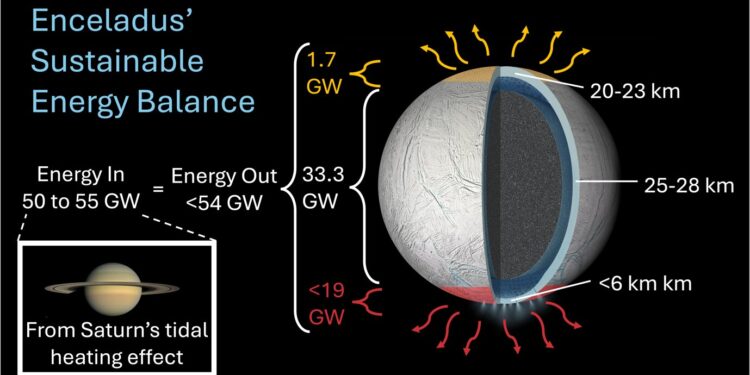A new study has constrained Enceladus’ overall conductive heat flow by studying its seasonal temperature variations at its north pole (yellow). These results, when combined with existing ones from its highly active south polar region (red), provide the first constraint for observing Enceladus’ energy loss budget (<54 GW) – which is consistent with the predicted energy contribution (50 to 55 GW) from tidal heating. This implies that Enceladus' current activity is sustainable in the long term – an important prerequisite for the evolution of life, which is thought to exist in its global subsurface ocean. Credit: University of Oxford / NASA / JPL-CalTech / Space Science Institute (PIA19656 and PIA11141)
A new study by researchers at the University of Oxford, the Southwest Research Institute and the Planetary Science Institute in Tucson, Arizona, has provided the first evidence of significant heat flow at Enceladus’ north pole, overturning previous assumptions that heat loss was confined to its active south pole.
This discovery confirms that the icy moon emits much more heat than would be expected if it were simply a passive body, strengthening the hypothesis that it could support life.
The research is published in the journal Scientific advances.
Enceladus is a very active world, with a global salty subterranean ocean believed to be the source of its heat. The presence of liquid water, heat and suitable chemicals (such as phosphorus and complex hydrocarbons) means that its underground ocean is considered one of the best places in our solar system for life to have evolved outside of Earth.
But this underground ocean can only support life if it has a stable environment, with its energy losses and gains in balance. This balance is maintained by tidal heating: Saturn’s gravity stretches and squeezes the moon during its orbit, generating heat within it. If Enceladus doesn’t gain enough energy, its surface activity will slow or stop, and the ocean could eventually freeze. On the other hand, too much energy could lead to an increase in ocean activity, thus altering their environment.
“Enceladus is a key target in the search for life outside Earth, and understanding the long-term availability of its energy is essential to determining whether it can support life,” said Dr Georgina Miles (South West Research Institute and visiting scientist in the Department of Physics, University of Oxford), lead author of the paper.
Until now, direct measurements of Enceladus’ heat loss had only been made at the south pole, where spectacular plumes of water ice and steam erupt from deep cracks in the surface. In contrast, the North Pole was considered geologically inactive.
Using data from NASA’s Cassini spacecraft, researchers compared observations of the north polar region during deep winter (2005) and summer (2015). These were used to measure how much energy Enceladus loses from its “hot” subterranean ocean (0 °C, 32 °F) as heat passes through its icy shell to the moon’s icy surface (–223 °C, –370 °F) and is then radiated into space.
By modeling expected surface temperatures during the polar night and comparing them to infrared observations from the Cassini Composite Infrared Spectrometer (CIRS), the team found that the surface of the north pole was about 7 K warmer than expected. This discrepancy could only be explained by heat escaping from the ocean below.
The measured heat flux (46 ± 4 milliwatts per square meter) may seem small, but it represents about two-thirds of the heat loss (per unit area) through the Earth’s continental crust. Across Enceladus, this heat loss by conduction amounts to around 35 gigawatts: roughly equivalent to the power of more than 66 million solar panels (power of 530 W) or 10,500 wind turbines (power of 3.4 MW).
When combined with the previously estimated heat escaping from Enceladus’ active south pole, the Moon’s total heat loss amounts to 54 gigawatts, a figure that closely matches the predicted heat gain from tidal forces. This balance between heat production and loss strongly suggests that Enceladus’ ocean can remain liquid over geological timescales, providing a stable environment where life could potentially emerge.
“Understanding how much heat Enceladus is losing on a global scale is crucial to knowing whether it can support life,” said Dr Carly Howett (Department of Physics, University of Oxford and Planetary Science Institute in Tucson, Arizona), corresponding author of the paper. “It is truly exciting that this new result supports the long-term sustainability of Enceladus, a crucial element for the development of life.”
According to the researchers, the next key step will be to determine whether Enceladus’ ocean has existed long enough for life to develop there. At the moment, his age is still uncertain.
The study also demonstrated that thermal data can be used to independently estimate the thickness of the ice shell, an important measurement for future missions planning to probe Enceladus’ ocean, for example using robotic landers or submersibles. The results suggest that the ice is 20 to 23 km deep at the North Pole, with a global average of 25 to 28 km, somewhat deeper than previous estimates obtained using other remote sensing and modeling techniques.
“Eliminating the subtle surface temperature variations caused by Enceladus’ conductive heat flow from its daily and seasonal temperature changes was challenging, and was only made possible by Cassini’s extended missions,” added Dr. Miles. “Our study highlights the need for long-term missions to ocean worlds likely to support life, and that the data may not reveal all of its secrets until decades after it is obtained.”
More information:
Georgina Miles et al, Endogenous heat at the north pole of Enceladus, Scientific advances (2025). DOI: 10.1126/sciadv.adx4338. www.science.org/doi/10.1126/sciadv.adx4338
Provided by the University of Oxford
Quote: Saturn’s icy moon could host a stable ocean suitable for life (November 7, 2025) retrieved November 8, 2025 from
This document is subject to copyright. Except for fair use for private study or research purposes, no part may be reproduced without written permission. The content is provided for informational purposes only.



